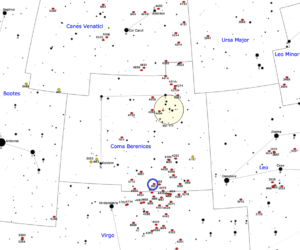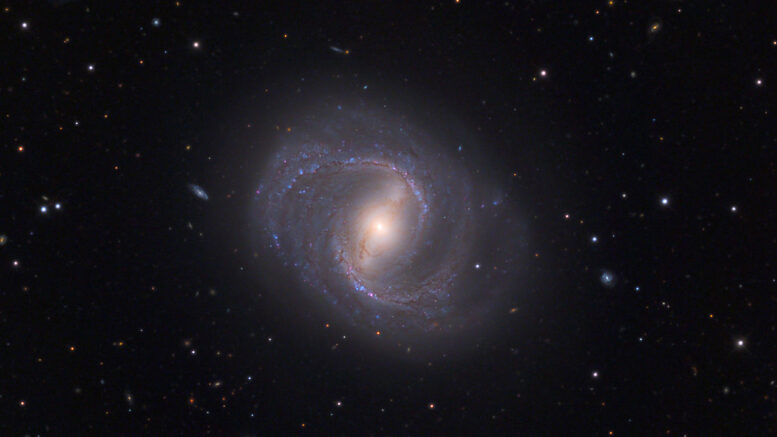Messier 91 is a barred spiral galaxy located in the Virgo Cluster, in the constellation Coma Berenices. There was some confusion over where Messier 91 was located as Messier 91 was given the location of Messier 58 by Messier himself. It wasn’t until 1969 that the object we now know as Messier 91 was identified as the Messier 91 that Charles Messier found.
Messier 91 is classified as an anemic galaxy, which is to say, it is a spiral galaxy with very little gas and a low rate of star formation compared to similar galaxies. M91 is home to about 400 billion stars. It is the faintest of all Messier objects and one of the most difficult to observe.
| Description | |
| Visible From Pacific Northwest | January to July |
| Best Time To Observe | May |
| Minimum Size Of Viewing Device | Medium Sized Telescope |
| Object Type | Barred Spiral Galaxy |
| Designations | Messier 91, M91, NGC 4548, PGC 41934, UGC 7753, IRAS 12328+1446, VCC 1615, VPC 995, ALFALFA 1-361, 2MASX J12352642+1429467, MCG+03-32-075, SDSS J123526.44+142946.8, ZZ 99-96, Z 1232.9+1446 |
| Right Ascension | 12h 35m 26.4s |
| Declination | +14°35m 26.4s |
| Constellation | Coma Berenices |
| Number Of Stars | 400 billion |
| Apparent magnitude | +11.0 |
| Apparent dimensions | 5′.4 x 4′.3 |
| Object Radius | 50,000 light years |
| Distance From Earth | 63,000,000 light years |
History
Messier 91 is one of Charles Messier’s original discoveries. Messier found it on March 18, 1781, along with seven other galaxies in the Virgo Cluster , which correspond from M84 to M92. M91 was the last member of the Virgo Cluster that Messier discovered that night. He described the object as a “nebula without star, in Virgo, above the preceding No. 90;” adding that “its light is still fainter than that of the above.” Messier did note the presence of other “nebulae” in the region following his entry for M91.
Messier 91 was a missing Messier object for a long time as a result of a mistake made by Messier, who had logged the object’s position from Messier 58 instead of Messier 89. The 91st entry in the Messier Catalogue was believed to be either a passing comet or a duplicate observation of M58.
William Herschel observed the object on April 8, 1784 and catalogued it as H II.120, describing it as large and round.
John Herschel catalogued M91 as h 1345 and later included it in his General Catalogue as GC 3093, describing the object as “bright; large; little extended; little brighter toward the middle.”
Herschel suspected his h 1367 (GC 3120) to be Messier’s 91st entry, but it wasn’t until 1969 that amateur astronomer William C. Williams identified NGC 4548 as M91, which was noted by William Herschel in 1784.
Locating M91 In The Sky
Messier 91 can be found about a degree north of the border between Coma Berenices and Virgo and north of the line connecting the bright star Denebola in Leo constellation and Vindemiatrix in Virgo. The slightly brighter elliptical galaxy M89, which lies about 60 percent of the way from Denebola to Vindemiatrix, is located 2 degrees south of M91. The best time of year to observe M91 and other galaxies in the Virgo Cluster is during the spring.

Viewing M91
It is the faintest of all Messier objects and one of the most difficult to observe. Small telescopes at medium power can reveal hints of the bar structure under exceptionally good conditions, but the bar is better seen in photographs than visually.
In 6-inch and 8-inch telescopes, the galaxy appears as a faint patch of light with a brighter centre. Larger instruments show the bright bar region and, depending on the conditions, the galaxy’s spiral arms.
Photographing M91
It is indeed possible to capture several Messier objects when capturing Messier 91 in an image. It is indeed possible to capture M91 without 2+ hours of content in terms of photos. Using a 6 inch telescope with automatic guidance, one only needs 20 photos with 300 second exposures with a modified Canon T3i (600D) for example to provide a wonderful photo.
Sources And Further Reading
Descriptions of all of Messier Objects can be found here.
https://www.nasa.gov/feature/goddard/2017/messier-91
http://www.messier.seds.org/m/m091.html

Be the first to comment on "Messier 91"